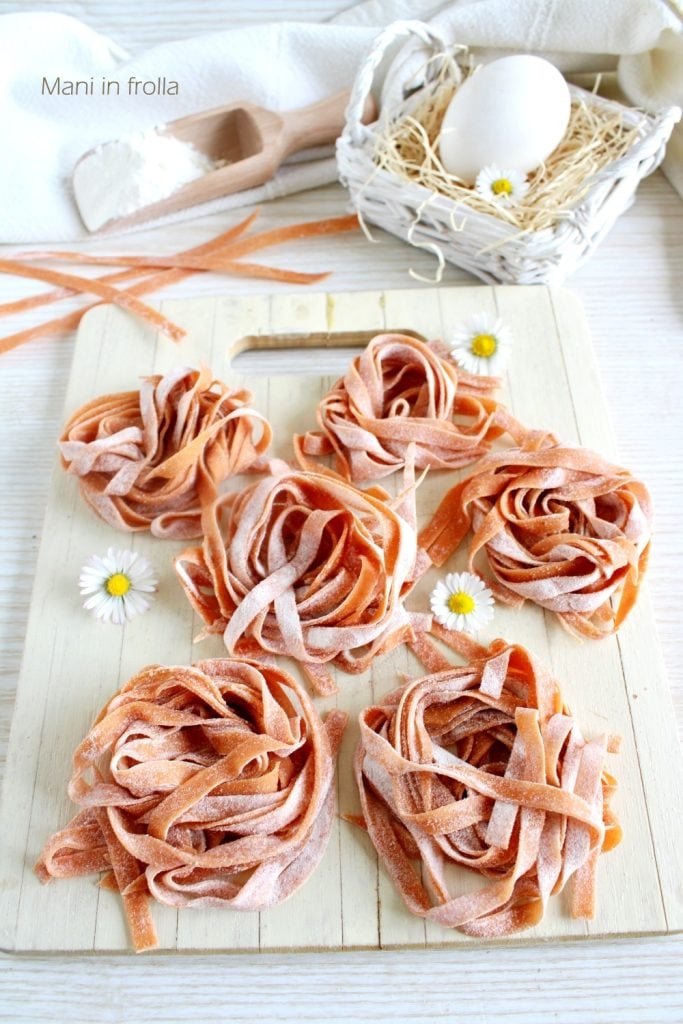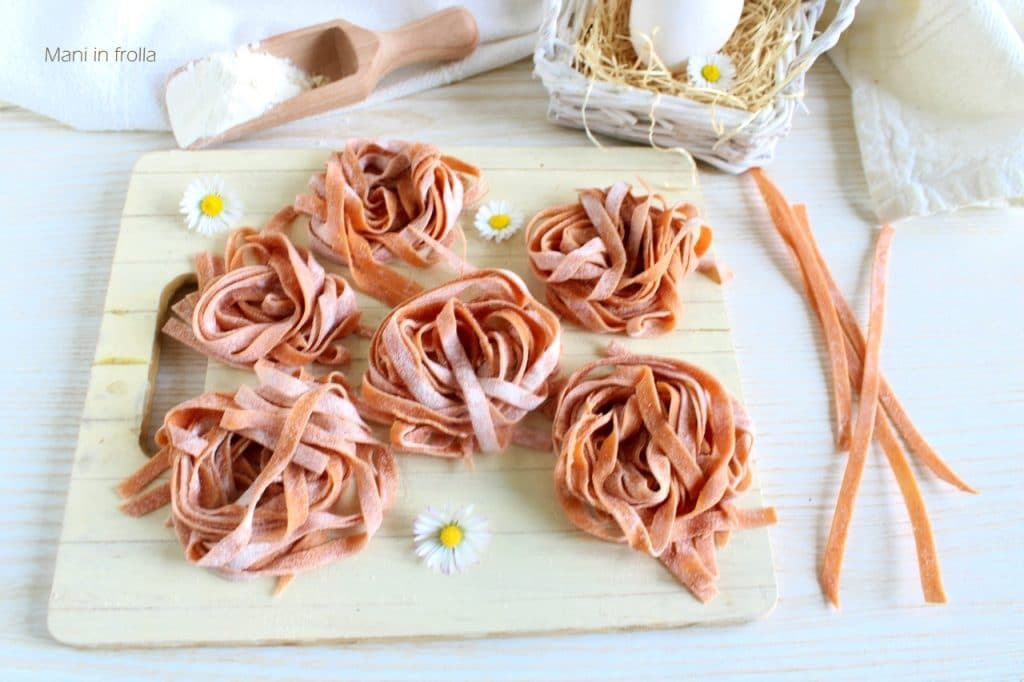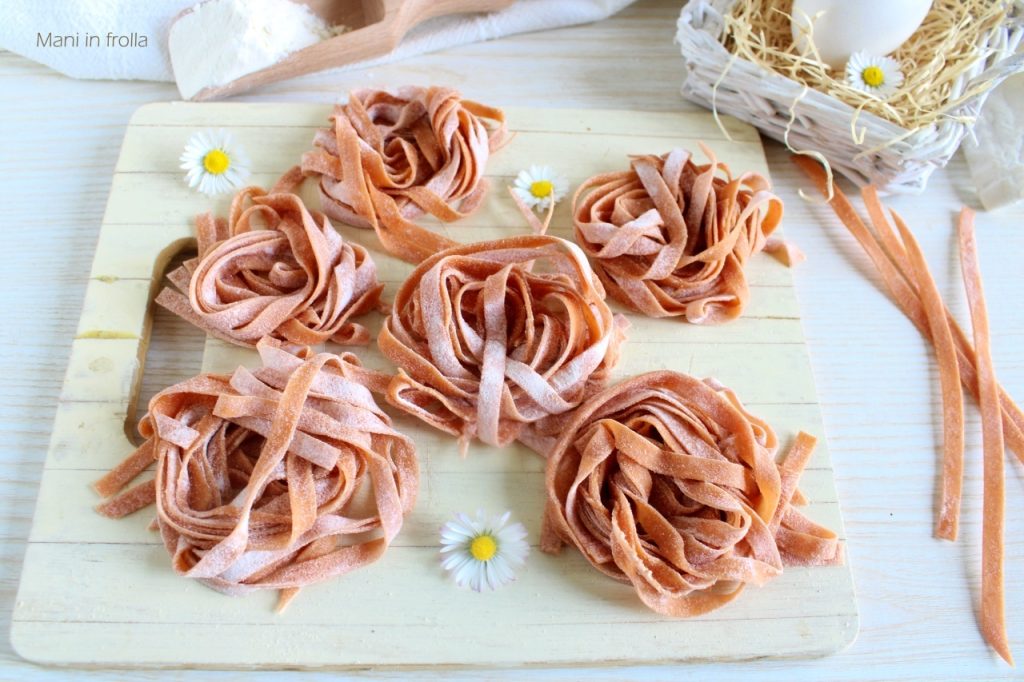Tagliatelle with tomato paste, a colorful and flavorful variation of classic egg pasta, perfect for a Sunday lunch or a special dinner.
The basic dough is similar to traditional egg tagliatelle, with the addition of tomato paste that gives the pasta an intense reddish-orange color. The ingredients are kneaded until a smooth and elastic dough is obtained, which is then rolled out and cut into strips.
The amount of tomato paste can be varied according to personal taste and is an excellent alternative to traditional egg pasta.
Alternatively, you can also try the carrot-colored tagliatelle or the beet tagliatelle.
For a perfect result, read the tips and suggestions at the end of the recipe.
Let’s see together how to make the recipe for Tagliatelle with tomato paste. Prepare the ingredients as we begin.
And if you try them, don’t forget to let me know in the comments on my Facebook page HERE. I’ll be waiting for you.
Gabriella
Other homemade pasta recipes:

- Difficulty: Easy
- Cost: Economical
- Rest time: 30 Minutes
- Preparation time: 15 Minutes
- Portions: 6People
- Cooking methods: Stovetop
- Cuisine: Italian
- Seasonality: All seasons
Ingredients
- 2 cups flour
- 2 eggs (at room temperature)
- 2 tbsps tomato paste (or more, to taste)
- as needed water (warm, if needed)
- as needed semolina flour (for the work surface)
Tools
- 1 Work Surface
- 1 Pasta Maker
Steps
Preparation of Tagliatelle with Tomato Paste
On the work surface, arrange the flour in a mound, break the eggs in the center, and add the tomato paste (the amount is up to you: I used 20 g). Knead for a long time, aiming for a very elastic dough, adding flour if it’s sticky, or a tablespoon of water if it’s too hard.
Shape the dough into a spherical form, cover it with a cloth, and let it rest for at least 30 minutes.

If using a stand mixer, place the flour and eggs in the bowl and start mixing, add the tomato paste and continue kneading, trying to obtain a very elastic dough, adding flour if sticky, or a tablespoon of water if too hard.
After the necessary time has passed, roll out the thin sheet with a rolling pin or with the help of a pasta machine (roller).
Take one piece of dough at a time, pass it through the pasta roller with the slot at its maximum width. Pass it several times, then gradually reduce the thickness until you achieve the desired one.Place the obtained sheets on the slightly floured work surface and keep them spaced apart.

At this point, still with the pasta machine (the ‘nonna papera’ as it’s called), cut the pasta into strips. Lay them on the lightly floured work surface with semolina flour and let them dry.
Here are the Tagliatelle with Tomato Paste ready.

Until the next recipe


Storage
You can store the tagliatelle with tomato paste like this:
– in the refrigerator: generously dust the tagliatelle with semolina flour to prevent them from sticking, place them in an airtight container or well-sealed food bags. In this way, you can consume the pasta within a couple of days to ensure maximum quality.
– dried: place the tagliatelle on a frame or pasta drying rack, in a cool and dry place, let them dry completely for 1-2 days, and finally store the dried pasta in paper bags or airtight containers.
– dried: place the tagliatelle on a frame or pasta drying rack, in a cool and dry place, let them dry completely for 1-2 days, and finally store the dried pasta in paper bags or airtight containers.
Tips and Suggestions
– Always use semolina flour for dusting the pasta, as it absorbs moisture better and prevents sticking.
– Ensure the pasta is completely dry before storing to avoid mold formation.
– Choose fresh eggs at room temperature. The number of eggs can vary depending on the moisture of the flour. Generally, one egg is used for every 100 grams of flour.
– You can knead by hand on a wooden work surface or use a stand mixer with a hook. The dough should be smooth, elastic, and not sticky.
– Wrap the dough in plastic wrap and let it rest for at least 30 minutes at room temperature. This step allows the gluten to relax, making the pasta easier to roll out.
– Some people add a pinch of salt and a drizzle of olive oil to the dough, but it’s not necessary, as salt is usually added to the cooking water. Oil can help make the dough more elastic and easier to work with (this is particularly useful when rolling out the sheet, as it helps prevent tears and breaks) and can make the pasta softer. Ultimately, adding oil is a matter of personal preference. If you want more elastic and softer pasta, you can try adding a tablespoon of extra virgin olive oil to the dough. If you prefer, like me, to follow the traditional recipe, you can omit it.
– Roll out the sheet with a rolling pin or pasta machine, starting from a thicker setting and gradually reducing until you achieve the desired thickness.
– Roll the sheet onto itself and cut it into strips of the desired width. Alternatively, use the specific accessory of the pasta machine.
Cooking and Dressing
– Cook the tagliatelle in plenty of salted water for a few minutes, until they float to the surface.
– Egg tagliatelle pairs perfectly with a wide variety of dressings, from classic Bolognese sauce to fish sauces, mushrooms, pesto, or vegetable-based dressings
– Egg tagliatelle pairs perfectly with a wide variety of dressings, from classic Bolognese sauce to fish sauces, mushrooms, pesto, or vegetable-based dressings
IF YOU LIKE MY RECIPES, YOU CAN ALSO FOLLOW ME ON MY FACEBOOK PAGE HERE OR ON PINTEREST HERE OR EVEN ON INSTAGRAM HERE
Return to the Home Page to read other recipes

